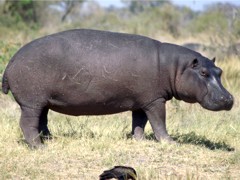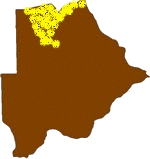Hippopotamus - Hippopotamus amphibius
German: Flusspferd; French: L'Hippopotame amphibie; Spanish: Hipopotamo
Italian: Ippopotamo; Polish: Hipopotam; Setswana: Kubu
What is it?
A huge amphibious mammal, Africa's second heaviest big game species after the elephant.
Characteristics
Enormous, barrel-shaped greyish-brown and pinkish hairless bodies, massive heads and relatively short legs. The tiny ears, eyes and nostrils are placed prominently on the head so that it can still hear, see and smell when its head is in low-profile, semi-submerged. There are short, hard bristles on the head, back and small, flattened tail.
They have 4 toes.
Shoulder height males 145-165 cm; females 130-145 cm.
Weight males usually 1.5 - 2 tonnes, exceptionally up to 3.2 tonnes; females 1.3 - 2.3 tonnes, usually around 1.4 tonnes.
When they open their mouths in a “yawn” or threat display the impressive recurved tusks (enlarged canines) can be seen, the bottom ones up to 50 cm or more in males and honed sharp against the shorter top ones. Hippos, especially males, frequently fight for territories and herd dominance, and the skin gashes inflicted by these tusks can be readily be seen on the heads and torsos of many of them. The lower middle incisors of males are elongated and cylindrical in form.
They have the largest mouth of any "land" mammal.
Gestation 8 months; one calf born any time of the year, with a peak in summer. Calving takes place on land or in shallow water.
Their far-carrying grunts or honks are one of the characteristics sounds of the African wilds. The sound of air being expelled from their nostrils is characteristic of their presence.
They are partial to lying up in shallows near deeper water which they take to when feeling threatened. On cool days they will stand or lie down dozing in the sun for hours. When sunbathing, they exude a pinky skin secretion that protects them from sunburn and skin drying.
Distribution: Okavango River, Okavango Delta, Linyanti, Kwando and Chobe Rivers, Thamalakane and Boteti Rivers
Status in Botswana: Common in the Northern wetlands, channels, lagoons, lakes, pools and rivers. Protected animal.
Habitat: Permanent water (rivers, lakes, pools), at least 1.5 m deep, usually deeper, adjacent to grazing areas.
Best places to see: Okavango River, Okavango Delta, Moremi Game Reserve - Quini loop, Dombo Hippo Pools, Khwai River, Chobe River front, Kwando River, Linyanti.


Photo 1
Photo 2
Photo 3
Photo 3
Video clip
Diet
Vegetarian, grazing short grasses mostly at night, though also snack occasionally in daylight, especially in the cooler part of the day. Grasses are plucked with the horny-edged lips. May consume up to 40 kg fodder per night. Where hippos have been regularly grazing the grass has a close-cropped “lawn” appearance. May also feed off submerged grass.
Longevity
35-40 years.
Notes
Social organization: a dominant bull with a “harem” of females with their young and younger and/or subordinate males. Herds usually comprise 10-15 individuals, but much larger herds may be found. At night, after emerging from the water, with the exception of cows with their calves, hippos graze singly. Some bulls live in bachelor herds or singly.
Formidable size and power deters predators, though very occasionally lions will gang up on and kill a hippo, and large crocodiles may snatch a small calf from its mother, though the latter is normally too vigilant to allow this to happen. Hippopotami guard their aquatic territories aggressively. Rare instances of hippos attacking and killing other animal species that venture too close to them in the water have been recorded (such as antelopes swimming to safety from pursuing predators), though, of course, hippos give way to elephants bathing or swimming near them.
Adult hippos can remain submerged for up to 6 minutes; typically, however, after diving they usually resurface within about 2 minutes. Whilst they usually sleep semi-submerged in shallow water, or even on dry land, they are capable of sleeping in deep water rising at regular intervals to breathe.
They swim well under water and can walk and run (with remarkable, ballet-like lightness and grace) along the bottom of rivers and lagoons.
Warning
They have a reputation for being ill-disposed towards human intruders and for causing more human injuries and deaths than any other African mammal. Certainly, they should not be closely approached by motor boat or dug-out canoe; this is particularly true of mothers with small calves, and old bulls sometimes become cantankerous. In certain situations where they are used to passing river traffic (such as on the Chobe River) hippos have generally become more tolerant of boats, but the unexpected can happen and a prudent distance between boat and hippo should always be maintained.
Hippos grazing near water, when feeling threatened, may charge straight to the water attacking human obstacles in their way, so one should never interpose oneself between these animals and their aquatic retreat where they feel secure. For such heavy animals they are surprisingly fast and on land can reach (usually by trotting, occasionally, when stressed, by galloping) speeds of 25-30 kph in short bursts.
page and site still under construction
All rights reserved. Copy rights (design, images, text and graphics) by Marek Marciniak, Richard Randall - 2007